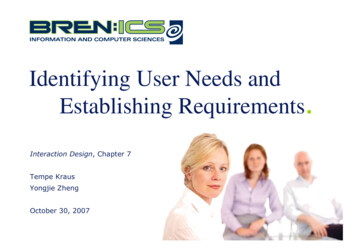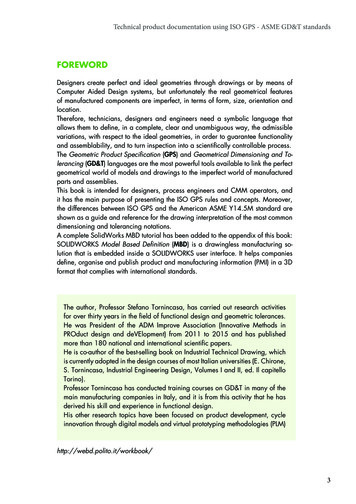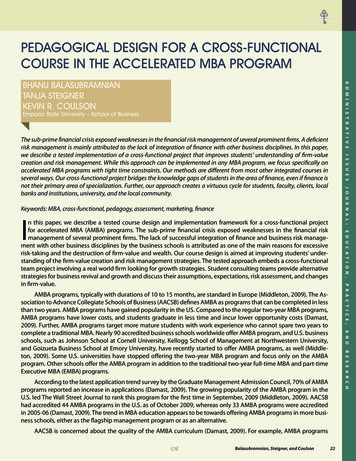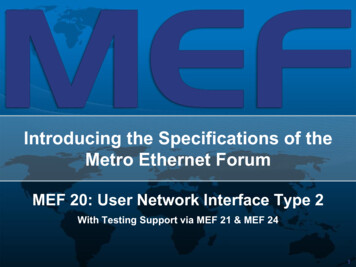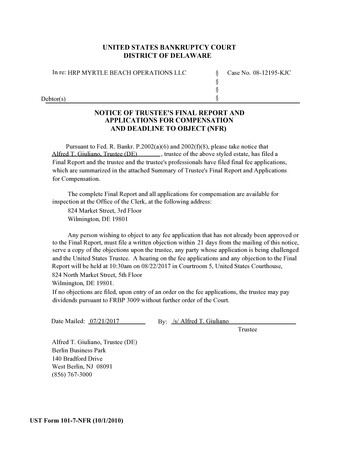
Transcription
Non-FunctionalRequirements (NFR)FrameworkA Subset of the Enterprise ArchitectureFrameworkA White Paper by: Rajesh RadhakrishnanSr. Managing Consultant/Sr. IT ArchitectIBM Global Technology ServicesSeptember 2009
Non-Functional Requirements (NFR) FrameworkCopyright 2009 The Open GroupAll rights reserved. No part of this publication may be reproduced, stored in aretrieval system, or transmitted, in any form or by any means, electronic,mechanical, photocopying, recording, or otherwise, without the priorpermission of the copyright owners.This White Paper is an informational document and does not form part of theTOGAF documentation set. Readers should note that this document has notbeen approved through the formal Open Group Standards Process and doesnot represent the formal consensus of The Open Group Architecture Forum.ITIL is a registered trademark of the UK Office of Government Commerce(OGC).Boundaryless Information Flow and TOGAF are trademarks and MakingStandards Work , The Open Group , UNIX , and the “X” device areregistered trademarks of The Open Group in the United States and othercountries.All other brand, company, and product names are used for identificationpurposes only and may be trademarks that are the sole property of theirrespective owners.Non-Functional Requirements (NFR) FrameworkDocument No.:W098Published by The Open Group, September 2009Any comments relating to the material contained in this document may besubmitted to:The Open Group44 Montgomery St. #960San Francisco, CA 94104or by email to:ogspecs@opengroup.orgComments on the content of this document may be submitted to the author gA White Paper Published by The Open Group2
Non-Functional Requirements (NFR) FrameworkTable of ContentsExecutive Summary4Introduction5Stakeholders for Non-Functional Requirements7Non-Functional Requirements for What?8Service Non-Functional Requirements and Service Lifecycle9Service Design and Development.9Service Transition.9Service Operations .10Service Improvement.10Arriving at Requirements12Service Quality Dimensions (Service Non-FunctionalRequirements)13Prioritizing Non-Functional Requirements15NFR Lifecycle16Analysis and Planning for Non-Functional Requirements .16Architecture for Non-Functional Requirements .17Engineering for Non-Functional Requirements.17Operating for Non-Functional Requirements .17Non-Functional Requirements-Related Monitoring .18Non-Functional Requirements-Related Improvements .18Summary .19Service Performance and Capacity.20NFR Framework22Service Availability .23Service Continuity .25www.opengroup.orgReferences26About the Author27About The Open Group27A White Paper Published by The Open Group3
Non-Functional Requirements (NFR) FrameworkBoundaryless Information Flow achieved through global interoperabilityin a secure, reliable, and timely mannerExecutive SummaryThis White Paper focuses on Non-Functional Requirements (NFR) for IT and IT-enabledbusiness services and proposes the creation of enterprise architecture artifacts specificallyaddressing NFR. It describes an NFR lifecycle and framework.One of the major goals of enterprise architecture planning, development, andimplementation is the alignment between business goals and objectives and IT capabilities.As business strategy and architecture (Phase B of the TOGAF Architecture DevelopmentMethod (ADM)) drives IS and IT architecture and capabilities (Phases C and D of theADM), the center piece of all architecture efforts and projects is requirements management.As enterprise architecture groups typically develop a set of artifacts such as building blocks,patterns, and reference architectures, among others, artifacts associated with requirementsbecome key and re-usable assets for several enterprise architecture projects.Service functional requirements vary greatly from industry to industry and from onebusiness function to another. While there is variation in service non-functional requirements,there are opportunities to create enterprise-specific standard templates for non-functionalrequirements such as: www.opengroup.orgA set of NFR dimensions prioritized or rank-orderedA set of resiliency tiers, with each tier having specific targets for resiliency metricsA standard set of data security requirements for customer or employee dataA standard set of requirements associated with compliance to an industry regulation, etc.A White Paper Published by The Open Group4
Non-Functional Requirements (NFR) FrameworkIntroductionFunctional and non-functional requirements are the center piece of most enterprise architecture frameworksincluding TOGAF Version 9. 1 All phases of the TOGAF 9 Architecture Development Method (ADM)relate to requirements and requirements management.Quotes from TOGAF 9: “Every stage of a TOGAF project (architecture projects that comply with the TOGAF ADM) is based onand validates business requirements.” “Requirements are identified, stored, and fed into and out of the relevant ADM phases, which address,prioritize, validate, and dispose of these requirements”.This White Paper organizes requirements into functional and non-functional requirements and focuses onnon-functional requirements (NFR). The NFR Framework impacts (has potential benefits for): Enterprise architecture projects1The Open Group Architecture Framework (TOGAF), Version 9 is available at www.opengroup.org/architecture/togaf. It is referredto in the rest of this White Paper as “TOGAF 9”.www.opengroup.orgA White Paper Published by The Open Group5
Non-Functional Requirements (NFR) Framework Enterprise technology domain architecture & design projects (such as enterprise storage architectureprojects) Business service(s) architecture & design projects (for example, CRM service) IT service(s) architecture & design projects (for example, email service)The ADM in TOGAF 9 has been applied to security. 2 The ADM for security is actually the ADM applied forsecurity architecture and security requirements. Security itself is a non-functional requirement. Similarly, theADM can be applied to other non-functional requirements dimensions such as availability, continuity, andefficiency, among others.An organization publishing its NFR Framework document as an enterprise architecture artifact and as part ofits enterprise architecture will help the enterprise with: Identifying a set of non-functional requirements dimensions as service qualities and sub-qualities that arerelevant to the enterprise Prioritizing these non-functional requirements dimensions from a business perspective; i.e., genericenterprise-level prioritization which helps with specific service architectures – individual service-levelnon-functional requirements prioritization may use this document as a guideline and can vary the servicespecific prioritization scheme Documenting methods to arrive at non-functional requirements, which helps the enterprise to re-use andapply methods to arrive at service-specific non-functional requirements Re-using non-functional requirements-related metrics and metric target levels for each IT and IT-enabledbusiness service Map business objectives to non-functional requirements, non-functional requirements to specifications(technology domain and process specifications), and to non-functional requirements-relatedmetrics/metric targets Developing service tiers (or service classes) based on non-functional requirements-related metrics andtarget levels; service tiers, or service classes would be another enterprise architecture artifact where mostenterprise IT and IT-enabled business services are bucketed into one of these service tiers via a servicerationalization process Mapping enterprise architecture and enterprise domain architecture patterns, building blocks, andproducts to service tiers (with varying non-functional requirements)2Refer to TOGAF 9, Chapter 21, Security Architecture and the ADM.www.opengroup.orgA White Paper Published by The Open Group6
Non-Functional Requirements (NFR) FrameworkStakeholders for Non-Functional RequirementsSenior management and the corporate board generally provide strategic guidelines, directives, and objectiveswhich can be translated to high-level non-functional requirements. As a case in point, after events such asSeptember 11 in New York and Hurricane Katrina in New Orleans, several enterprises have upped theirpriority for business continuity and have had directives from senior executives and the board to developbusiness and IT service continuity capabilities and, in fact, have set business and IT recovery objectiveswhich easily translate to service (business & IT service) continuity requirements.The business unit and business service owners also act as customers of IT and IT-enabled business servicesand do state high-level objectives which can translate to requirements.The business owners, sometimes, also delegate authority to customer liaisons (as buyers of IT services) andthey represent end users to provide input for IT and IT-enabled business service requirements. The customerliaisons set the requirements for an IT or IT-enabled business service and represent the business owners, theend users, and other service stakeholders. The liaisons provide input for service requirements from abusiness, end-user, and regulatory perspective, among others.The customer is part of the business and sets expectations (requirements) while the requirementsmanagement team (architects) and service-level management team from IT help gather, define, refine, anddocument a set of funded requirements and define solutions that can meet these documented requirements.www.opengroup.orgA White Paper Published by The Open Group7
Non-Functional Requirements (NFR) FrameworkNon-Functional Requirements for What?This White Paper focuses on non-functional requirements for IT and IT-enabled business services. Servicenon-functional requirements are essentially the same as service qualities. Services (both IT and IT-enabledbusiness services) are designed, developed, transitioned, managed, and improved using: Information system (application, integration, and data) architecture and capabilities Technology (network, server, storage, among others) architecture and capabilities Process (business & IT processes) architecture and capabilities Organization (business & IT) architecture and capabilitiesService requirements also need to be translated to information systems (IS), information technology (IT),process, and organizational requirements. This translation process, which helps with requirements mappingand traceability, is further discussed in NFR Lifecycle.Most business and IT environments have built IS, IT, process and organizational capabilities. Therefore, inmost cases, business & IT have to work together to leverage current capabilities and tune them to meet orexceed service functional and non-functional requirements. For example, a requirement to restore a run-timeservice (the service quality being Service Recoverability) within 30 minutes after a service outage impliessuch technology requirements as development, replication, and maintenance application images and serverimages for fast recovery, application, and server clustering for fast failover, standby db for fast failover, andso on. The same 30-minute time to restore service requirements implies advanced event and incidentmonitoring and management requirements (process requirements) such as less than three minutes to detect anincident, less than three minutes to escalate, and so on. Information system requirements can be that allapplication components should allow for watchdog capabilities for automated application component faultdetection, restart, and recovery. Organizational requirements can be a 24 by 7 support team with less thanthree-minute response time as part of an Operational Level Agreement (OLA) within the enterprise and aspart of support contracts with the service-related vendors.www.opengroup.orgA White Paper Published by The Open Group8
Non-Functional Requirements (NFR) FrameworkService Non-Functional Requirements and Service LifecycleService non-functional requirements (or service quality requirements) impact the entire service lifecyclefrom service design, to development, transition, operation, and improvement (ITIL v3 Service Lifecyclestages).Service Design and DevelopmentTraditionally, service design and development focused on functional requirements while service operationsfocused on non-functional requirements. However, with the advent of service quality-related IntegratedDevelopment Environment (IDE) tools and technologies, service qualities – such as service availability,performance, and security – are being factored into the service design and development lifecycles. The ITindustry has made major progress in the last few years in terms of pulling forward non-functionalrequirements into the service lifecycle.As organizations fund service design and development efforts that focus on non-functional requirements, theup-front investment made on the service development cycle is likely to be paid off via improved serviceresilience and performance against non-functional requirements. For example, developing servicecomponents that comply with the Distributed Management Task Force (DMTF)/Service Availability Forum(SAF) Hardware Platform Interface (HPI) and Application Interface Specification (AIS) can surely improveservice availability and minimize the costs associated with service unavailability. Similarly, J2EEapplications that comply with JSR 88 Live Application Upgrade capabilities will require less downtime formaintenance windows, thereby minimizing costs associated with planned or scheduled applicationmaintenance windows.Applications designed to work with enterprise event monitoring and management capabilities can prevent aset of service incidents by leveraging event correlation for predicting service and service component failures.Advanced service security capabilities designed into the service – such as automated service-related changeauditing and reporting capabilities – can reduce security-related service incidents in production.Advanced service-specific state monitoring and capturing capabilities – such as the DTrace utility for Solaris(UNIX ) services – can help with quick root cause analysis, problem management, and control of problemrelated costs (for example, labor hours spent on Root Cause Analysis (RCA)).Service TransitionService transition focuses on service verification, testing, and validation while preparing services forproduction readiness. There are several verification, testing, and validation capabilities focused on nonfunctional requirements. However, due to time-to-market (services) issues and aggressive schedules, servicetransition activities are frequently rushed through. This results in bringing services to production withoutappropriately testing and validating non-functional requirements-related service capabilities.Currently, most organizations focus service testing and validation cycles over certain non-functionalrequirements, such as load testing as part of service capacity and performance management. Resiliencytesting (such as availability and continuity testing) is left for the service operations phase of the servicelifecycle.Most organizations and industry bodies recognize the need to beef up service transition capabilities as mostorganization recognize that their service transition capabilities are the weakest part of their service lifecyclecapabilities.www.opengroup.orgA White Paper Published by The Open Group9
Non-Functional Requirements (NFR) FrameworkHowever, prioritization of service qualities or non-functional requirements dimensions at the enterprise level(by business and enterprise architecture teams) and at the service level can help service teams to developspecific testing and validation capabilities for those non-functional requirements dimensions that are of thehighest priority.Also, the higher the level of non-functional requirement – i.e., the higher the service-level requirements – thehigher the level of service transition work including verification, testing, and validation. For example, thehigher the level of required service availability, the more the need for testing of specific service availabilitybuilding blocks, such as clustering software or autonomic systems.In several cases, the non-functional requirements-specific building block – such as clustering and availabilitymonitoring software for an application – may very well be a set of vendor products well-tested and provenby the vendor. However, the primary testing by the organization buying these non-functional requirementsbuilding blocks would be integration testing (integration with the overall solution) and testing to validate theclaims of the vendor when it comes to the organization-specific service implementation (of the vendorbuilding block). However, this level of integration testing and testing to validate capabilities against nonfunctional requirements and vendor claims are key for identifying potential scenarios via test cases where theoverall solution may not meet the non-functional requirements.Service OperationsInfrastructure building blocks which host service building blocks are a key part of meeting non-functionalrequirements in the production or operation phase of a service lifecycle.A sample set of infrastructure building blocks linked to a set of services is shown below: Clustered servers hosting web services Grid network hosting VoIP services Content Addressed Storage (CAS) hosting content management application Storage Area Network (SAN) hosting multimedia content services Clustered appliance hosting DNS servicesJust as infrastructure building blocks and their specifications are important for meeting or exceeding nonfunctional requirements in the operational environment, operational processes – such as event, incident andproblem management, production configuration, change, release, and deployment management – are alsokey for non-functional requirements.Service design processes such as availability, continuity, performance/capacity, and security managementprocesses also play a significant role in the production environment when it comes to service availability,continuity, performance/capacity, and security.Service ImprovementContinuous Service Improvement (CSI) and Service Improvement Plans (SIP) involve services, such as: Availability improvement plans Performance/capacity improvement plans Utilization improvement planswww.opengroup.orgA White Paper Published by The Open Group10
Non-Functional Requirements (NFR) Framework Continuity improvement plans Security improvement plans Cost improvement plans Usability improvement plansEach plan aligns with a service quality (non-functional requirements dimension) and leverages patterns,building blocks, emerging and new technologies that improve performance with regard to one or moreservice quality (non-functional requirements dimension).www.opengroup.orgA White Paper Published by The Open Group11
Non-Functional Requirements (NFR) FrameworkArriving at RequirementsBoth functional and non-functional requirements can be elicited from different stakeholders via: Workshops Focus groups Interviews Story-boarding (scenarios)and can logically flow (be distilled) from: General stakeholder hopes, dreams, and fears to Practical expectations, wishes, and concerns to Measurable requirements to Funded in-scope and documented functional and non-functional requirementsThis method to arrive at requirements is graphically shown below.www.opengroup.orgA White Paper Published by The Open Group12
Non-Functional Requirements (NFR) FrameworkService Quality Dimensions (Service Non-Functional Requirements)While the dimensions of functional requirements vary significantly from one service to another, thedimensions of non-functional requirements need not vary as much. Therefore, an enterprise service NFRFramework with a baseline of service non-functional requirements, associated capabilities (patterns, buildingblocks), and associated metrics can be developed at the firm and industry level and made part of theenterprise architecture, enterprise technology domain architecture, standards, governance, and servicemanagement. These industry and organization-specific non-functional requirements artifacts can driverequirements management for most if not all IT and enterprise architecture projects. This White Paper coversa generic (industry-agnostic) NFR Framework.Dimensions of service non-functional requirements or service quality are: Service Availability (& Continuity): reliability, manageability, serviceability, performance (responsetime), recoverability, and continuity, among others Service Assurance: security, confidentiality, integrity, credibility, non-repudiation, and data protection,among others Service Efficiency: cost of service per unit, utilization, and service activity monitoring, among others Service Usability: ease-of-use, locatability, accessibility, and locale (international operations capability),among others Service Adaptability: interoperability, scalability, portability, modularity, and extensibility, amongothersEach service quality (non-functional dimension) and its sub-qualities has a set of metrics associated with itand the target level for this metric becomes the service requirement or service-level requirement.For example, Service Reliability is a Service Availability sub-quality and two key metrics associated withService Reliability are Mean Time Between Service Failure (MTBSF) and Mean Time Between ComponentFailure (MTBCF) (service component). The MTBCF for a hard drive as a service component can range frommonths to years. The target of five years (or 60 months) of operations before disk failure, for a set of diskdrives that are part of a service (say email), is a requirement (design specification) associated with a servicecomponent.Similarly, serviceability is a Service Availability sub-quality and can have several metrics associated withthe same. The total hours-of-service maintenance window and the number of service maintenance windowper year are key metrics. A service can have a requirement of 24-hour maintenance window once per quarterwhich implies a maximum of 96 hours of maintenance window per year. So the serviceability requirementsare a maximum of four maintenance windows per year which require scheduled service outage and amaximum of 24 hours per service maintenance window.Service component (resource) utilization is a service efficiency metric and the target of 80% logical diskspace utilization level is a requirement. Virtualization and dynamic logical disk scaling (scaling up or down)technologies, combined with resource monitoring technologies, allow for managing resource utilizationlevels in real time.www.opengroup.orgA White Paper Published by The Open Group13
Non-Functional Requirements (NFR) Framework(Adapted from TOGAF Service Qualities)Important Note: Several of these key service qualities and sub-qualities have one or more IT processes thatmap to them in such IT process frameworks as ITIL. Examples are service design processes such as serviceavailability management, service continuity management, service performance & capacity management, andservice security management, among others.www.opengroup.orgA White Paper Published by The Open Group14
Non-Functional Requirements (NFR) FrameworkPrioritizing Non-Functional RequirementsSeveral firms treat availability, continuity, and security as the most critical non-functional requirements andclassify them as such. The remaining non-functional requirements dimensions are important but treated assecondary when compared to availability, continuity, and security. The prioritization scheme may vary fromone industry to another and one organization to another.As a case in point, an online brokerage firm competing on the basis of cost and value to its customer cantreat service efficiency – especially from a cost structure perspective – as critical to the firm’s strategy andcompetitive advantage. As such, efficiency becomes a key non-functional requirements dimension both fordomain architectures and service architectures. In fact, the online brokerage firm’s IT department has adedicated and collaborative process to constantly look for opportunities for cost-cutting (cost take-out) andimplements them faster than its competition. This enterprise was among the first in the industry to replaceseveral of its high-end UNIX systems with low-end Linux systems in the 1990s. The penetration of low-costLinux systems in the firm’s data centers is also highest for the industry.An enterprise’s business and IT strategy, business model, and industry and regulatory environments are someof the factors that determine the prioritization scheme.www.opengroup.orgA White Paper Published by The Open Group15
Non-Functional Requirements (NFR) FrameworkNFR LifecycleEach service quality or service non-functional requirement has a certain lifecycle which starts withrequirements definition and gathering to realizing the defined and funded requirements.Analysis and Planning for Non-Functional RequirementsAnalysis and planning for non-functional requirements produces service-level objectives and service-levelrequirements. Also, it produces (IS and IT) domain-level objectives and requirements. Analysis and planningfor non-functional requirements includes leveraging an organization-specific NFR Framework and artifacts(which helps with requirements definition) and initial gathering of non-functional requirements. Certainservice-specific non-functional requirements can be arrived at via planning and analysis activities. As a casein point, service continuity requirements can be arrived at via business impact analysis, service impactanalysis, and risk analysis – all three analytical activities are part of service continuity management in theITIL IT process framework. Similarly, cost of service unavailability analysis can help the organization arriveat service availability requirements. These analytical methods that produce service requirementsdocumentation are typically part of an IT process and involve stakeholders discussed earlier (seeStakeholders for Non-Functional Requirements).The table below shows the mapping of specific analytical methods that lead to specific service qualityobjectives and non-functional requirements.Planning & Analysis Leads to Service Quality Objectives and Non-Functional RequirementsCost of Uniavailability, Service Failure Impact Analysis (SFIA), Component FailureImpact Analysis (CFIA), Fault Tree Analysis (FTA), Failure Mode Effect &Capability Analysis (FMECA)AvailabilityRisk Analysis, Business Impact Analysis (BIA),CCTA Risk Analysis & Management Method (CRAMM)ContinuityCCTA Risk Analysis & Management Method (CRAMM),Consultative, Objective, & Bi-functional Risk Analysis (COBRA)AssuranceService Cost Structure Analysis, Business Process Re-engineering (BPR)Analysis, Energy Consumption AnalysisEfficiencyEase-of-Use Analysis, Service Acceptance Analysis, Service Accessiblity AnalysisUsabilityBusiness Model & Operating Models, Business Modularity Analysis,Service Modularity Analysis, Compatibility AnalysisAdaptibilityBusiness scenarios are key outputs of analytical work associated with non-functional requirements. Thesebusiness scenarios can have associated use-case scenarios. As an example, there are several businessscenarios associated with business continuity events, security events, among others. The same is true withscenarios with regard to business service availability. The scenario analysis gets more complicated withoutsourcing of certain business and IT processes and services. However, artifacts documenting businessscenarios and use-case scenarios associated with non-functional requirements can benefit the enterprise froma planning perspective, particularly when these artifacts are re-used and applied when different groups areengaged in documenting non-functional requirements related to the service they are developing ormaintaining.www.opengroup.orgA White Paper Published by The Open Group16
Non-Functional Requirements (NFR) FrameworkArchitecture for Non-Functional RequirementsArchitecture for non-functional requirements refines non-functional requirements and develops architecturespecifications. Service architecture specifications (email architecture specifications) and domain architecturespecifications (network architecture specifications), are some of the key outputs of this phase. Nonfunctional requirements-related use-case scenarios and use-cases are also key outputs of this phase. Mappingof non-functional requirements to standards are also part of this phase. Domains include application, data,and integration (IS) domains as well as network, server, storage, facilities, systems management, desktop,and other such technology
The ADM in TOGAF 9 has been applied to security.2 The ADM for security is actually the ADM applied for security architecture and security requirements. Security itself is a non-functional requirement. Similarly, the ADM can be applied to other non-functional requiremen ts dimensions such a


